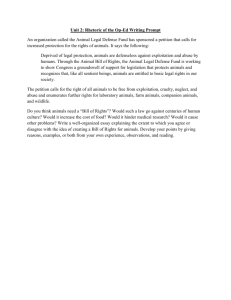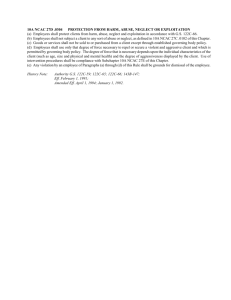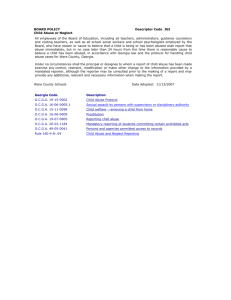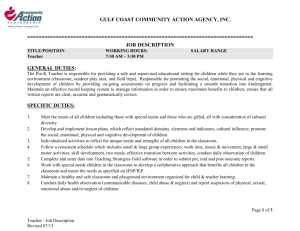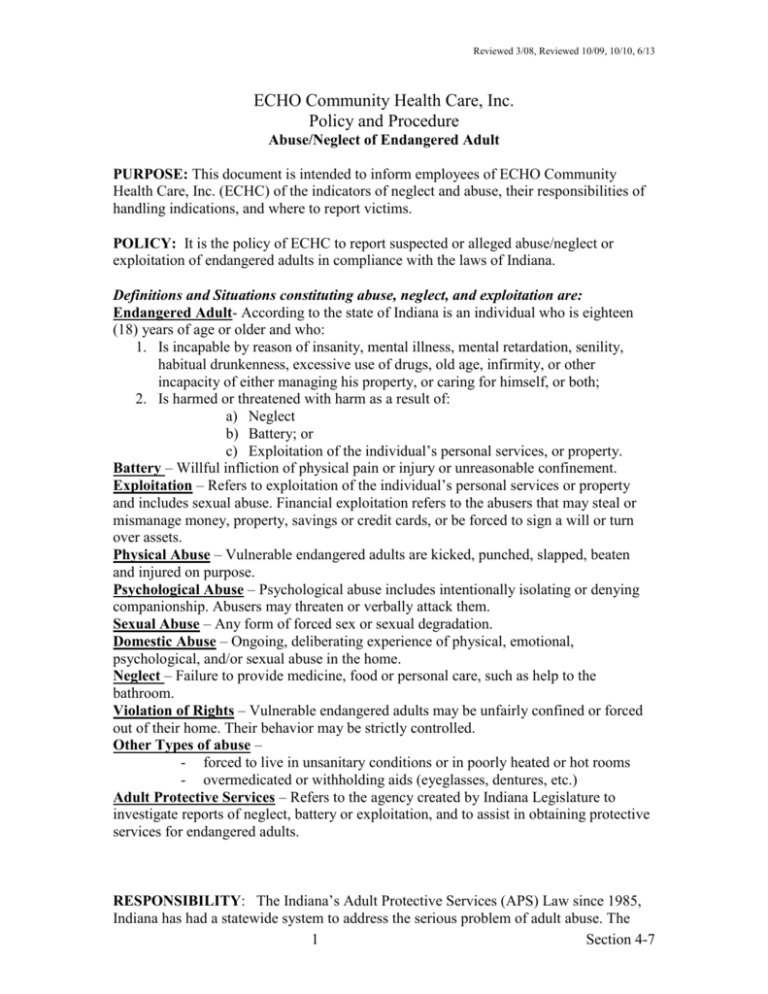
Reviewed 3/08, Reviewed 10/09, 10/10, 6/13
ECHO Community Health Care, Inc.
Policy and Procedure
Abuse/Neglect of Endangered Adult
PURPOSE: This document is intended to inform employees of ECHO Community
Health Care, Inc. (ECHC) of the indicators of neglect and abuse, their responsibilities of
handling indications, and where to report victims.
POLICY: It is the policy of ECHC to report suspected or alleged abuse/neglect or
exploitation of endangered adults in compliance with the laws of Indiana.
Definitions and Situations constituting abuse, neglect, and exploitation are:
Endangered Adult- According to the state of Indiana is an individual who is eighteen
(18) years of age or older and who:
1. Is incapable by reason of insanity, mental illness, mental retardation, senility,
habitual drunkenness, excessive use of drugs, old age, infirmity, or other
incapacity of either managing his property, or caring for himself, or both;
2. Is harmed or threatened with harm as a result of:
a) Neglect
b) Battery; or
c) Exploitation of the individual’s personal services, or property.
Battery – Willful infliction of physical pain or injury or unreasonable confinement.
Exploitation – Refers to exploitation of the individual’s personal services or property
and includes sexual abuse. Financial exploitation refers to the abusers that may steal or
mismanage money, property, savings or credit cards, or be forced to sign a will or turn
over assets.
Physical Abuse – Vulnerable endangered adults are kicked, punched, slapped, beaten
and injured on purpose.
Psychological Abuse – Psychological abuse includes intentionally isolating or denying
companionship. Abusers may threaten or verbally attack them.
Sexual Abuse – Any form of forced sex or sexual degradation.
Domestic Abuse – Ongoing, deliberating experience of physical, emotional,
psychological, and/or sexual abuse in the home.
Neglect – Failure to provide medicine, food or personal care, such as help to the
bathroom.
Violation of Rights – Vulnerable endangered adults may be unfairly confined or forced
out of their home. Their behavior may be strictly controlled.
Other Types of abuse –
- forced to live in unsanitary conditions or in poorly heated or hot rooms
- overmedicated or withholding aids (eyeglasses, dentures, etc.)
Adult Protective Services – Refers to the agency created by Indiana Legislature to
investigate reports of neglect, battery or exploitation, and to assist in obtaining protective
services for endangered adults.
RESPONSIBILITY: The Indiana’s Adult Protective Services (APS) Law since 1985,
Indiana has had a statewide system to address the serious problem of adult abuse. The
1
Section 4-7
Reviewed 3/08, Reviewed 10/09, 10/10, 6/13
law enacted (IC 12-10-3) requires individuals to report any knowledge of abused,
neglected, or exploited adults. Reports should be made to APS unit, APS statewide
hotline (1-800-992-6978), or to a local law enforcement agency.
A person who in good faith makes a report required to be made under this chapter,
or testifies at Administrative or judicial proceedings on matters arising from the
report is immune from any civil or criminal liability testimony.
No one person may be excused from testifying before a court or grand jury
concerning a report made under this chapter on the basis that the testimony is
privileged information, unless the person is an attorney, physician, clergyman, or
a spouse who is not a competent witness under IC 34-1-14-5.
No employer may discharge, demote, transfer, prepare a negative work
performance evaluation or reduce benefits, pay work privilege, or take any other
action to retaliate against an employee who in good faith files a report under this
chapter.
DOCUMENTATION:
The AMA guidelines recommend that the medical records include the following:
1.
2.
3.
4.
5.
The chief complaint and description of the abusive event or neglectful
situation, using the patient’s own words whenever possible.
Complete medical history.
A relevant social history.
A detailed description of injuries including type, number, size, location, stages
of healing, color, resolution, possible causes and explanations given. Polaroid
Photographs are encouraged and to be taken when ever possible, consent is to
be signed prior to photographs. Photographs are limited to the body area of
concern and the person’s face is not to be included. If the face is involved in
the affected areas then limit the photo to only the area of the face involved.
An opinion on whether the injuries were adequately explained.
Indicators of Neglect;
These are cues that require further assessment, DO NOT IGNORE
1.
Skin lesions unattended (insect bites, abrasions, etc.)
2.
Poor hygiene
3.
Malnutrition
4.
Dehydration
5.
Inadequate, torn or dirty clothing
6.
Decubiti
7.
Fecal impactions
8.
Unmet physical needs (decayed teeth, broken glasses, overgrown nails)
9.
Prolonged intervals between onset of illness and medical treatment
10.
Noncompliance or therapeutic failure (caregiver not providing appropriate
medication or treatment)
Indicators of Physical Abuse;
1.
Injuries and trauma that are inconsistent with reported cause
2
Section 4-7
Reviewed 3/08, Reviewed 10/09, 10/10, 6/13
2.
3.
4.
5.
6.
7.
8.
9.
(Cigarette burns, scratches, bruises, welts, lacerations, bites, etc.)
Hematomas
Bruises at various stages of resolution
Bruises, chafing or excoriation on wrists or legs (restraints)
Fractures inconsistent with the type of trauma described
Burns inconsistent with the type of trauma described
Unusual patterns of injuries (unusual location, inflicted with belt, hairbrush,
rope, repeated injuries)
Prolonged interval between injury and medical treatment
Drug toxicity/overdose
PROCEDURE:
A.
B.
C.
D.
E.
Treat any physical source of pain, use non-pharmacological measures, if possible,
such as positioning for comfort and ice.
Facilitate patient’s involvement in cooperating with the interview.
Document findings using the patient’s own words. Polaroid or digital photographs
are encouraged and to be taken whenever possible, consent is to be signed prior to
photographs. Photographs are limited to the body area of concern and the person’s
face is not to be included. If the face is involved in the affected areas then limit
the photo to only the area of the face involved. See attachment, ‘Photo Release’.
The Polaroid photos are placed in the medical record with the visit note.
If the patient acknowledges abuse, neglect or exploitation or you highly suspect
the patient has been abused neglected or exploited;
a. Notify the Social Worker
b. The Social Worker completes assessment of the situation and includes
the following information in narrative form in the social work eclinical
note. (IC 12-10-3-10):
(1) The name, age, and addresses of the endangered adult.
(2) The names and addresses of family members or other persons
financially responsible for the endangered adult’s care or other
individuals who may be able to provide relevant information.
(3) The apparent nature and extent of the alleged neglect, battery,
or exploitation and the endangered adult’s physical and mental
condition.
(4) The name, address, and telephone number of the reporter and
the basis of the reporter’s knowledge.
(5) The name and address of the alleged offender.
(6) Any other relevant information regarding the circumstances of
the endangered adult.
c. The Social Worker will notify proper authorities.
d. Locate a safe environment for the patient, if questionable consult with the
social service coordinator or appointed designee.
e. Arrange for transportation for the patient to that safe environment if
necessary.
Provide emotional support
3
Section 4-7
Reviewed 3/08, Reviewed 10/09, 10/10, 6/13
F.
If the patient is not ‘endangered’ and does not acknowledge abuse, do not attempt
to have the patient confront the situation, instead provide telephone numbers and
addresses for appropriate assistance and services available.
REFERENCES:
Indiana Code
Adult Protective Services of Indiana
4
Section 4-7

